It’s winter in Maryland. In fact, it’s so much winter I shoveled 10 inches of snow off my driveway this morning. Fortunately, I had company. It wasn’t the kind of company that picks up a shovel and helps out, but still, the American robins darting back and forth over my head were still welcome (if surprising and surprisingly quiet) snow day companions.
Become a Member
Make a lasting impact for nature when you join The Nature Conservancy
“You know,” I said to them as I leaned on my shovel to watch about 25 birds flock together in my neighbor’s oak. “I think y’all are a little early—aren’t you supposed to be the first harbingers of spring?”
We’re not even a month past the first day of winter in the northern hemisphere. Spring is definitely not here. So why are the robins? Shouldn’t they be sunning themselves in warmer climes?
The short answer: as long as there’s food, American robins—true to their name Turdus migratorius (“the wandering thrush”)—kind of spend their winters coming and going as they please.
Robin Migration (AKA Robin Wandering)
Robins do migrate—but they don’t necessarily follow a more or less straight line from north to south in the fall, then repeat the journey south to north in the spring. In the fall and winter, when the ground freezes, robins lose access to their meal of choice: worms, insects (adult and larval) and (occasionally) snails. That’s when they turn to their winter diet staple: mostly fruit, mostly berries.
The folks at Journey North, a project tracking robin movements run by the University of Wisconsin-Madison, put it this way, “Some robins retreat all the way to southern Texas and Florida (in fact, some of the largest winter flocks documented by the Christmas Bird Count gather in sunny St. Petersburg, Florida), but others winter as far north as they can find berries. So they have an enormous winter range. Robins do migrate, but it has more to do with food sources than with being faithful to the same places year over year.”
In that way American robins are somewhat akin to teenage boys—they tend to go where the best (or most abundant or most easily accessible) food is, stay until it’s depleted, and then move on.
So as long as there are enough berries and other fruits to sustain them, you may see robins off and on throughout the winter across much of North America.
Forget the birdseed though. Robins’ digestive systems, unlike sparrows or other so-called feeder birds, aren’t built for dealing with seed, and their beaks aren’t built for cracking things open. Robin beaks are built for snapping up worms, catching insects, and plucking berries and other fruits. In the winter, a flock of robins can strip a holly bush with impressive speed and efficiency, and very little—if any—violent robin-on-robin aggression.
Food is also one of the reasons that robins, notoriously territorial and aggressive in breeding season, tend to gather and travel in flocks in the fall and winter. Numbers are good for defense, and also for spotting food—if one robin happens on a holly tree full of bright, ripe berries, the whole flock can partake. And then move on.
The tendency of robins to flock in winter may also be one of the reasons people seem to notice them—birds in large numbers tend to stand out when they’re gathered in leafless trees. (That and the beautiful red breast that is sometimes the only splash of color in a winter landscape that looks practically lunar in relentless shades of February white and gray.)
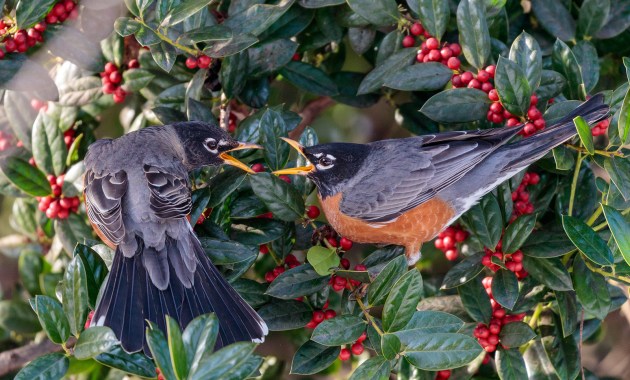
How do Robins Survive the Cold?
Robins are outfitted to survive huge temperature variances. In fact, hot weather seems to stress them more than cold.
If an American robin is healthy, has enough to eat, and is able to main its feathers, the temperature next to its body stays around 104 F—regardless of how cold it is in the world outside. It really is all about those feathers. (And the legs and feet.)
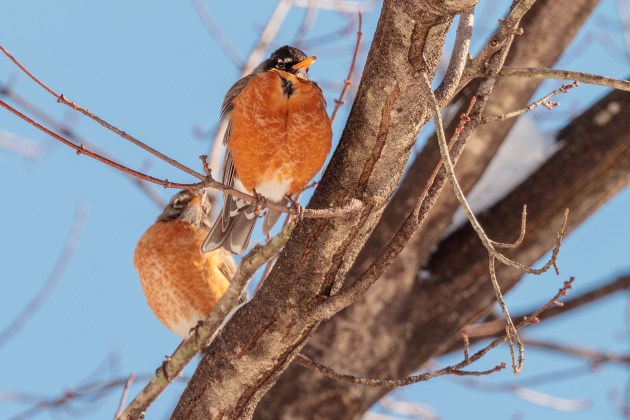
Robins, like most birds, have layers of feathers that perform different functions. When temperatures drop, robins puff the fine, downy feathers closest to their bodies to keep heat in, cold out. The outer feathers act like a kind of overcoat, shedding water and moisture and helping to regulate the bird’s temperature. (It’s an adaptation not limited to robins. Most birds with down feathers fluff them to regulate body heat).
The anatomy of a robin’s (and other bird species) also contributes to their cold adaptations. The bird experts over at the Cornell Lab explain it very well. The simplified version is that “most birds don’t succumb to frostbite because there is so little fluid in the cells of their feet, and their feet are mostly tendons and bones with little muscle or nerve tissue.”
So while blood does flow to their legs and feet, most birds (including robins) benefit from a very fast circulatory system and a “countercurrent heat exchange system.” Because bird legs are thin, the vessels that move blood from the heart to the feet and back again are very close together. That proximity means, per Cornell, “blood flowing back to the body is warmed by blood flowing to the feet. The newly cooled blood in the feet lowers heat loss from the feet, and the warmed blood flowing back into the body prevents the bird from becoming chilled.”
Robins: The Tell-Tale Birds of Spring
If robins are around in winter, why have they always been associated with the beginning of spring in the U.S.? Most likely it has to do with ground thaw, snow melt, and territorial behaviors like singing, worm hunting and nest building. But mostly, it’s the singing.
According to Journey North, which has a fantastic Q+A section I highly recommend for the robin-curious, “the robin’s song remains a reliable indicator that the first wave of spring migration has reached you. This song is one of the first signs that robins are switching from winter behavior to courtship and nesting behaviors associated with spring.”
Robins tend to move north as the ground thaws. The availability of high protein prey, especially worms that emerge with warmer, often wetter weather, is when a robin’s thoughts turn to procreation. And that’s the end of the cooperative fall and winter behaviors.
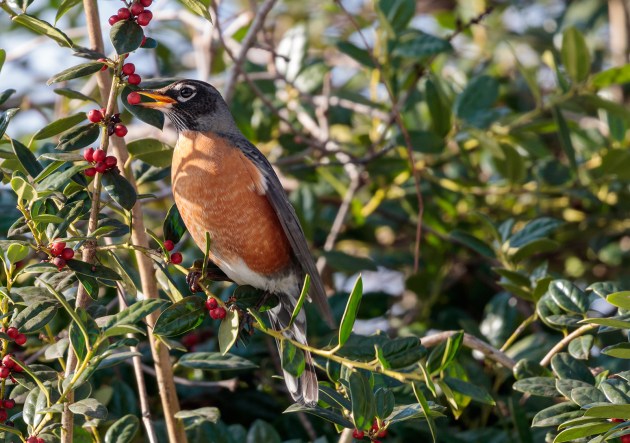
Which is one of the reasons many robins (primarily males) may stay through harsher winters instead of booking it to St. Petersburg: first access to the choicest nesting grounds. Breeding season is when robins also become more visible with mating displays, nest-building and a lot of time on the ground hunting for the tastiest worms. Until then, they’re all about the berries.
You Can Help Robins with Science from Your Own Backyard
Like many species, including other birds, scientists are starting to see some changes in robin behavior that is likely attributable to climate change. One study of American robins migrating to and from Canada’s boreal forest, showed that they’re beginning to journey south on average about 12 days earlier than in past years, or five days earlier per decade since 1994.
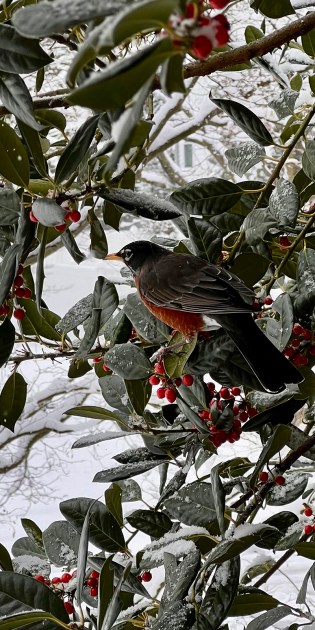
If you want to help scientists studying birds, there are several ways to contribute your observations (not just for robins, but for many of the species you can see outside your windows).
Journey North
You can submit your robin observations directly on the Journey North site (and check out their other migration-related citizen science projects). They also have 2025 maps tracking sightings so you can see where American robins (and other signs of spring) are being observed and follow along (and contribute to) the wanderings of Turdus migratorius.
Cornell Lab of Ornithology
The Cornell Lab has a number of different ways you can contribute to science for birds. Your sightings tracked on eBird (free) contribute to worldwide data for birding, science, and conservation. Want to know what birds are being seen in your neighborhood, eBird has a feature for that. If you’re new to birding, check out their genius birding ID app, Merlin.
You can also contribute to Project FeederWatch (requires subscription) by counting birds at your feeder from November through April. Your observations help scientists monitor changes in the abundance and distribution of birds, including the influence of changes in habitat, disease, and climate.
And mark your calendars for the 2025 Great Backyard Bird Count (February 14-17). Spend time in your favorite places watching birds—then report them to Cornell! It’s easy to participate, “in as little as 15 minutes notice the birds around you. Identify them, count them, and submit your counts to help scientists better understand and protect birds around the world. You can see the results from 2024 here.
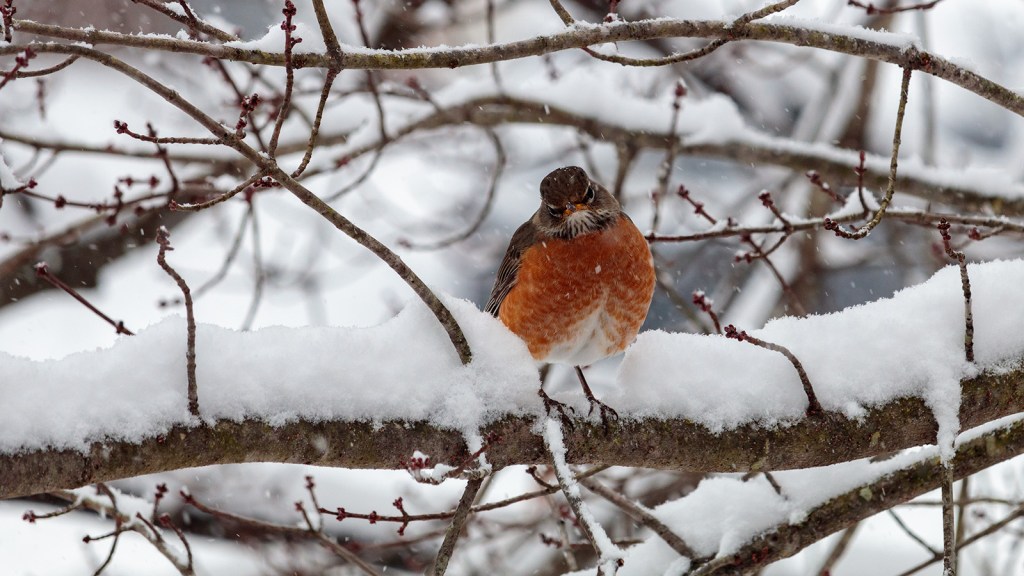



2 days ago our backyard looked like a bird freeway in New York!! Never have I seen so many Robins in our yard. I filled our birdbath up 3 times that first day! They seemed so happy to be in our back yard! I was flattered. They boosted my mood too. They seemed so happy. We had an unusually heavy crop of berries on our holly trees and our Nandias so I guess that is what brought them our way. It was a pleasant experience!
Today February 2 2021 I posted on FB seeing flocks of what I estimate to be hundreds of Robins all over my 4 acres. We have a pond and active stream( man made) they are bathing and enjoying the running water. I put mealy bugs out but they do not seem to be interested. No one else is either! Trying to encourage the Blue Birds I saw recently at the stream. I live in SW Michigan between Battle Creek and Kalamazoo. About a quarter of a mile from Gull Lake. Others have seen big flocks of Robins at the north end of the lake, and in our little town of Richland. Never seen so many especially in February. I’d like to think Spring will come early but I am not getting my hopes up!
As I read your article it’s February 2nd and I’m observing a flock of 20+ robins here in Iowa City, Iowa. I’ve noticed them off and on all winter. We have had about 12” of snow on the ground for about 6 weeks now. Perhaps I should set out a pan of water.
I live just north of San Antonio, Tx. We’ve had hundreds of robins for several weeks now. I have 2 bird baths & tubs of water for other animals. As beautiful as the robins are; I have to say their poop is horrible. It’s bloody red. I have to clean bird baths several times daily. They look like blood baths! Craziest thing I’ve ever seen. The red poop is everywhere. I’m assuming the poop is red from eating worms & cedar berries.
It is so fascinating to see the bands of robins going back and forth in neighbors yards in 33 degree temperture and eating red holly berries. I’m glad you shared info because I at first wondered if they were robins thinking you don’t see them until early spring and warmer weather. I was very excited and I put out a container with water.
I live in the Jonesville area of Florida. It is February 1, 2021 and I have seen groups of Robins coming to my birdbath latelly. They had white dots around their eyes.
I started seeing male robins yesterday here on my 2.5 wooded acres. This morning, February 1st, I must of had 40-50 in my front lawn. I do have a lot of fresh water and black oil sun flower seed out and keep it out year round. I live in NE corner of Parker County Texas. Beautiful to experience this moment in time!
jan 31, 2021, portsmouth,nh, 15degrees.
i was out filling birdfeeders when i heard the robins, my heart sunk!
i already have a mockingbird, a flock of tufted titmouse, anuthatch and the usual winter birds.
went back to the house and got more meal worms, fruit and berries and tossed them around
neighborhood. two of the birds were already on one of the water stations.
Sorry for the typing, my typing hand is in a sling.
Starting mid January noticed very large flocks of Robins in the trees Kalamazoo Michigan . Never seen such large active masses before and I’m always in the trails
Sunday, Jan 31 around 2 PM. I hear what sounds like a ton of birds around my house. I step out onto my front porch and see hundreds of a robins flying around the trees and especially around my neighbors house. I sit down to watch then realizing that they are all flocking around a big berry bush tree at my neighbors house each going down and out of the bush quick. I run to grab my iPad to record as I was interested in the bird. I landed on your page was researching what I saw.
Just saw a flock of a dozen + males and females in Warren, Michigan. 30 January 2021, noon, 5 miles north of Detroit. They were flicking dead leaves, sticks, & debris. Thanks for the great article!
Robins have invaded our yard this week in Hurst, Texas. We love them, and we enjoy seeing so many of them. I believe they are eating berries, but the ground is not frozen and it has been raining, so maybe they are eating bugs and worms too.
I just saw about 20 Robins in my backyard, I have several feeders and bushes with fruit. I was amazed to see Robins this early and had to research about seeing them in the winter.
It is 11 degrees(F) in Quincy, Massachusetts and a flock of about 50+ Robins came to a small park to eat some berries. Some were across the street as well, hanging out on the roofs and porches of some houses, Ive never seen so many together!!! Wow
Just had 2 robins in my tree. It’s the coldest day of the year in Manchester CT today. January 29, 2021